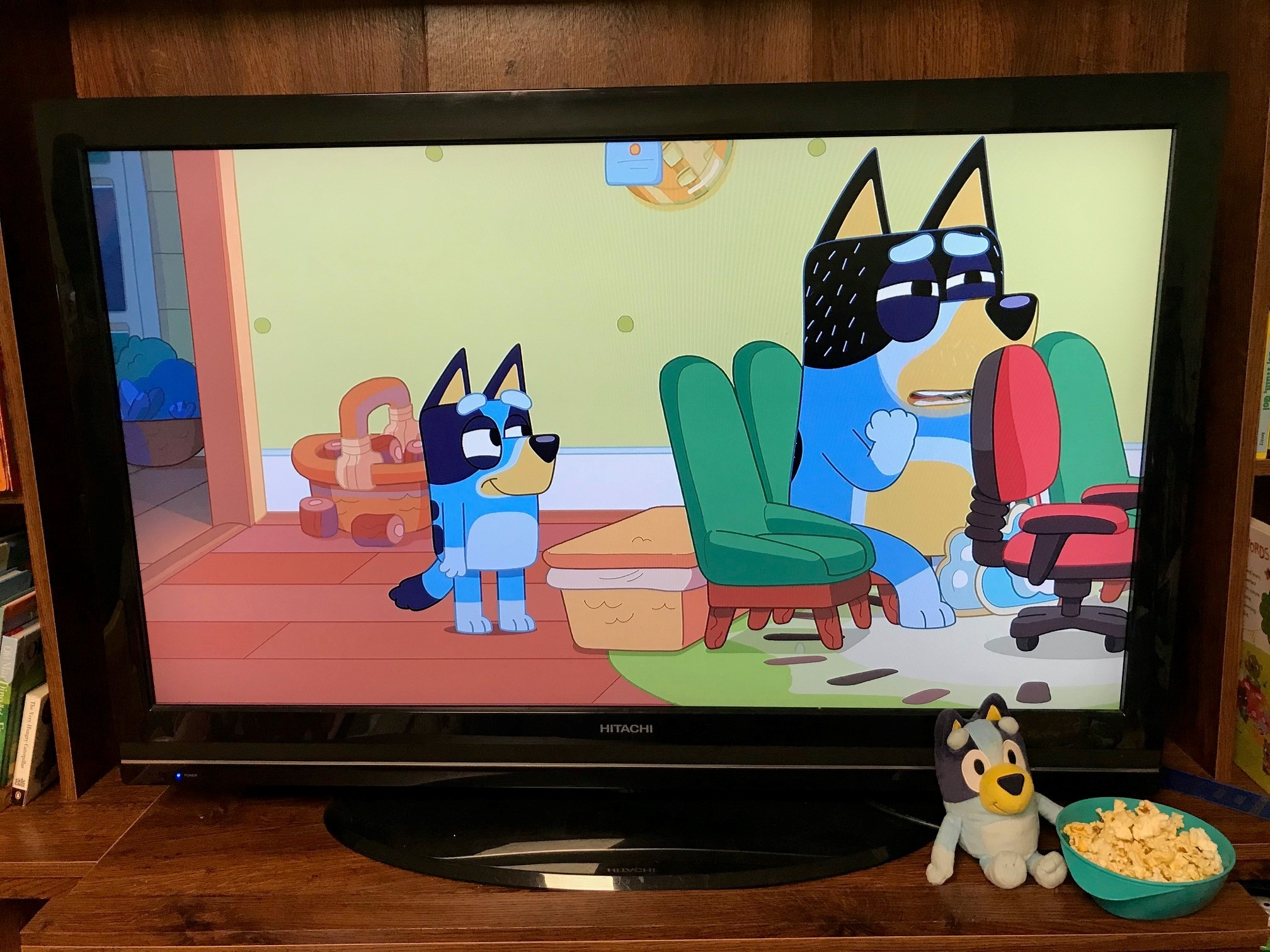Lessons on life, writing and storytelling from the creator of ‘Bluey’
Joe Brumm, the creative force behind the beloved animated sensation, shares guidance on finding the concise core of a story.

Watching cartoons with kids is often a chore to endure.
Anyone who’s had a child obsessed with the likes of “Paw Patrol” or “Dora the Explorer”—or, gulp, “Calliou”—can confirm that the lion’s share of children’s programming is either lousy, insipid or supremely annoying. Sometimes all three!
However, some cartoons are an absolute delight. That’s certainly the case with “Bluey.”
IMDB describes the show as, “The slice-of-life adventures of an Australian Blue Heeler Cattle Dog puppy as she has fun with her family and friends in everyday situations.” I’d describe it as perhaps the most charming, insightful show streaming anywhere right now. Every episode is a seven-minute slice of animation glee that playfully explores the prosaic interactions that fill our days. But it’s more than mere lighthearted fun for the whole family.
As the New York Times writes, “‘Bluey’ speaks with a rare frankness and authenticity not only about the experience of being a child, but, also, being a parent.”
Aside from the show’s admirable mix of levity, brevity and real-life challenges, there are plenty more lessons writers of all stripes can glean from “Bluey.”
Learning from the lead dog behind ‘Bluey’
“Bluey” is the brainchild of Joe Brumm, a Queensland native whose own kids provided ample fodder for the show’s relatable hijinks. As the NYT notes, Brumm started writing down the games his children would play, which he says would often devolve into “‘Monty Python’ bizarre scenarios.” The magic of “Bluey” is how it captures these tiny, zany moments that happen every day but so frequently go unnoticed or undocumented.
The NYT continues:
“It was equally important for him [Brumm] to show the charm and nostalgia of watching children grow up. One trademark of “Bluey” is the realistic dialogue and the constant dribble of random and amusing questions that young people ask about the world: ‘Where do rocks come from?’ ‘Why are some plants food, like lettuce, but other plants not food?’”
Brumm sums it up: “There’s so much hard work with kids and there’s so much laughter that’s going on in and around the cracks. I wanted to get to the core of what’s in the engine room of a family.”
We reached out to Brumm for more storytelling ideas and insights, and he was kind enough to respond. We’ve distilled the best bits of his advice below:
On writing influences and crafting better stories.
Brumm lists his biggest writing influences as Dan Harmon, Trey Parker and Matt Stone, and Ruth Jones.

Joe Brumm
He cites Harmon’s “story circle” technique, in particular, as a good starting point for anyone eager to shape crisper, more compelling narratives.
On brevity and deleting ancillary stuff.
Every communicator should note the tidy structure of “Bluey.” With each episode clocking in around seven minutes, there’s not a line or word to waste. Shrinking attention spans demand ruthless editing.
Brumm tries to “stick to a three-act structure/story circle so it feels like a character has been somewhere.” He also says the “Bluey” writers “rarely have B stories and just condense and condense” until they hit that magic seven-minute mark for an episode.
“If it’s not contributing to the story and I’m overlength it usually has to go,” Brumm says.
On distinguishing your writing amid a sea of sameness.
Brumm advises writers to actively lower the resistance they face in their creative process. Especially when you’re feeling uninspired. He touts the importance of having side projects that excite you and “keep you enthused” when your day job isn’t scratching that creative itch. On the topic of finding inspiration, he says:
“All I did was write what made me laugh, or feel something, or that I’d want to watch. It took quite a bit of effort to ring-fence that from outside forces. One bit of advice I got from a film-maker years ago was that you need a good balance of your left and right brain. It’s all well and good to be super logical, with a watertight structure, but your film will be boring and no-one will want to watch it. Equally if you are all imagination and wild ideas, no-one will be able to follow it. Best to marry the two, build a solid structure and decorate it with wild, unique premises and ideas.”
Brumm says the best “Bluey” episodes have “wild premises that follow rigid logic.”
On the “Bluey” creative process.
Brumm says:
“They usually start with a game, or game mechanic, usually from real life that I know will translate to screen well and make kids laugh. The nature of this game sometimes lends itself to a theme, which then becomes what the script is about. For Bluey it is usually about a kid growing out of toddlerhood into a more social creature, or the parent letting go of some vestige of selfishness.”
Brumm continues:
“I do my best to follow the simplified hero’s journey story circle summarized by Dan Harmon. Establish the main character, figure out what ‘god is yelling at them’ but they are not hearing, enter them into an unfamiliar place, chart them adapting and getting to the crux of the issue, the place where they need to break apart something in order to proceed. Then have them break that thing apart, making the requisite sacrifice, and then revel in the positive change that the whole process has brought about.”
On how communicators can incorporate animation into their toolkits.
Brumm says there’s no simple trick to create topnotch animation, “but to do it simply you can pick up loads of free cutout software or stopmotion stuff online.”
On becoming a better business writer.
For those toiling in the more mundane mines of corporate content, Brumm suggests: “Perhaps there is a structure underneath [that’s] similar to an essay? If so, find and perfect that ‘invisible’ structure, and remain curious and educated about the subject at hand so you have something to decorate it with.”
On the legacy of Bluey.
Brumm conveys that his aims for “Bluey” are quite modest, and that he’d like to see nothing less than the show becoming, “An indestructible series animation industry in my home state, Queensland, and in 20 years a bunch of adults listing it as one of their favorite cartoons growing up.”
Takeaways for comms pros
What about you, communicators? What kind of legacy do you hope to leave with your work? You might not create an internationally beloved cartoon, but what sort of difference can you make? It could be more profound than you even realize.
As “Bluey” masterfully illustrates, there is wonder, joy and laughter to be extracted from the mundane events of each day. Even in the slog of pandemic-era remote work. The trick is not letting those moments and opportunities pass you by—and being willing to document those small incidents of gratitude, kindness and inspiration.
If all else fails: You might also try incorporating cute pups with Australian accents into your storytelling somehow. Can’t go wrong there.








My kids and grandchildren love Bluey that is all they want to watch thank you so much for Bingo too just adorable
My kids and grandchildren love Bluey and Bingo that is all they want to watch thank you so much
This was a really great article. Amazingly generous of Joe to divulge the creative process behind Bluey. Really informative, thank you Joe and Robby.
Very thankful for this type of television series. My whole family enjoys it and it continues to be our homes favorite. We adore each episode please continue it for us
Hi, my niece & nephew love your show & learn so much from it!! I would love to see an episode including a nonverbal autistic character so they can have some understanding about their cousin, my son, Luca! It would be great & informative for parents as well😊
I love Bluey, even though it may be a little old for me. It is a very funny show, and teaches a lot of valuable life lessons. The characters a very funny, especially Dad. I hope they add on more episodes because I adore the show. My friends and I love and adore this show. I hope they keep creating more episodes.
Hello, I love Bluey, even though it’s made for kids it a show that everyone should watch. I think it would be great if in the beginning or end of the forth season Chilli could have a surprise pregnancy, and threw out the next few episodes it can show a little of the struggles of pregnancy. Then after the baby is born it can show the struggles of having a new baby in the house, how it can be hard for Bluey and Bingo but how they learn to adjust to it. I think this would be a really good idea, and something everyone would love to see. 😊
I love this idea
I LOVE BLUEY!
I think they should add in an episode where Uncle Rad and Aunt Frisky have a baby and they go to see the baby. I think this is a good idea because it would be fun for Frisky and Rad to settle down somewhere and have a baby, and this could teach kids about caring for others by showing Bluey and Bingo helping them with the baby.
I love this idea! I think it would be good for kids to learn to be helpful!